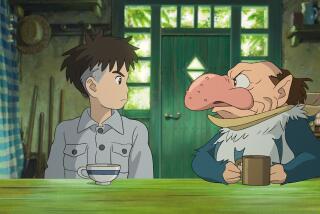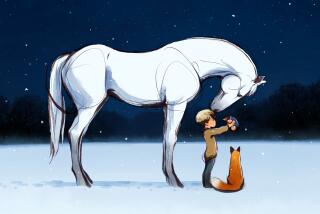Kidsâ Films by the Book
How do you translate beloved childrenâs books to film? Disney famously, some say infamously, uses them as a springboard to its own flights of fancy. For Weston Woods Studios, little known to the general public but a Disney-like giant in the world of libraries and schools, the book is sacrosanct.
For nearly 50 years, this modest film company has taken time--three or more years on a single project--to ensure that animation, narration and music are true to authors, illustrators and readers.
Now Weston Woodsâ treasure trove of living books is about to become widely available for the first time to the general public. In late September, Scholastic Entertainment began rolling out the Weston Woods library as the Scholastic Video Collection, distributed by New Video, with four titles: Maurice Sendakâs âWhere the Wild Things Are,â Kevin Henkesâ âChrysanthemum,â âChicka Chicka Boom Boomâ and âThe Night Before Christmas.â Other titles will be released annually.
Varied Animation Styles
Weston Woods founder Morton Schindel, who started the company on a borrowed shoestring in 1953 in Weston, Conn., had one guiding principle: âThe book was always our director,â he said.
He maintained that philosophy as his company became a multimillion-dollar business earning numerous education and film awards for excellence, including an Oscar nomination for William Steigâs âDoctor De Sotoâ and the American Library Assn.âs recent lifetime achievement award for the 86-year-old Schindel.
âMort had it written in the contracts that he would work with the editor, or the author and illustrator, and at any point, if they didnât like the production, he would throw it out and start over,â said Linda Lee, Weston Woods Studios vice president. âThatâs what we do today.â
Sendakâs âWhere the Wild Things Are,â with its intricate cross-hatching, is the âMt. Everest of childrenâs books,â according to its director, Gene Deitch, and it took five years to finish.
âWhen an artist puts paint on a canvas, it can be painted over till heâs satisfied that itâs just right,â Schindel said. âThatâs the way our films were made. Once we made a commitment to a project, we threw away the budget and the time schedule.â
The filmsâ varied animation styles, matched to the books, include paper puppets and collage, fine line drawings and watercolor brush strokes. Until 1964, however, the films were produced--as some still are today--using the iconographic method that Schindel invented.
With this technique, widely used by filmmakers since, still pictures are moved in front of a stationary camera, with zooms, pans and cross-dissolves adding to the illusion of movement.
From the beginning, wherever possible, the booksâ creators were involved throughout the process. They even suggested a composer or narrator.
âThey care passionately about maintaining the integrity of the book, and for an author and an illustrator, you couldnât ask for anything more,â Henkes said.
Keeping the Vision Alive
Will Scholastic Inc., which acquired Weston Woods as a separate division in 1996, continue to support this maverick, noncorporate, artisan-like approach to childrenâs filmmaking?
âAbsolutely,â said Linda Kahn, Scholastic Entertainmentâs senior vice president of programming and distribution. âWeston Woods decides what theyâre going to produce, and itâs completely up to them how [the films] are made. What weâre doing is reaching the consumer.â
Meanwhile, at an age when most have retired from the daily work grind, Schindel is still working to keep his vision alive, developing the nonprofit Weston Woods Institute, âwhere weâre hoping more people can be induced to make this kind of thing and do it well.â
More to Read
Sign up for our Book Club newsletter
Get the latest news, events and more from the Los Angeles Times Book Club, and help us get L.A. reading and talking.
You may occasionally receive promotional content from the Los Angeles Times.







